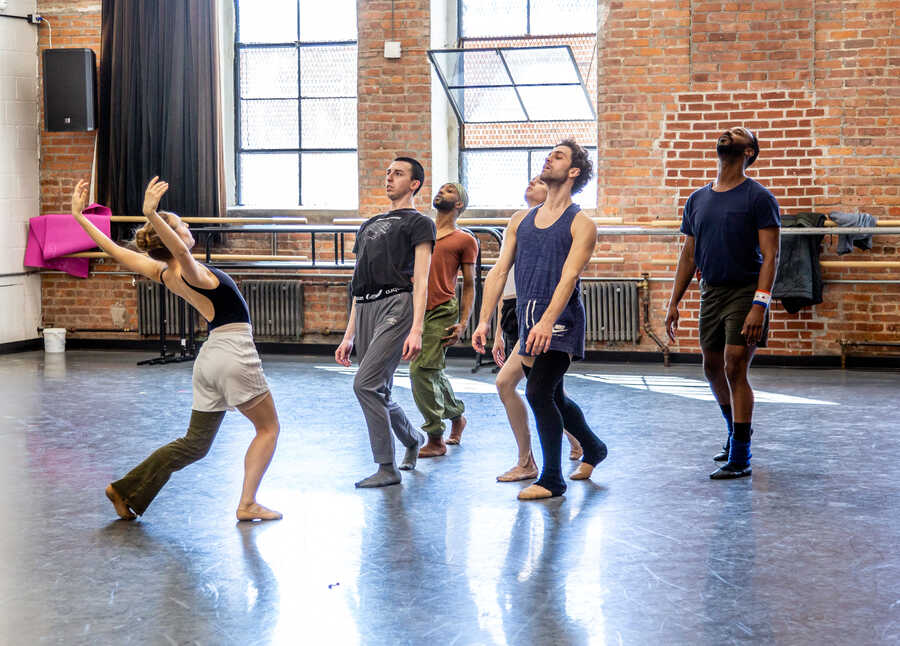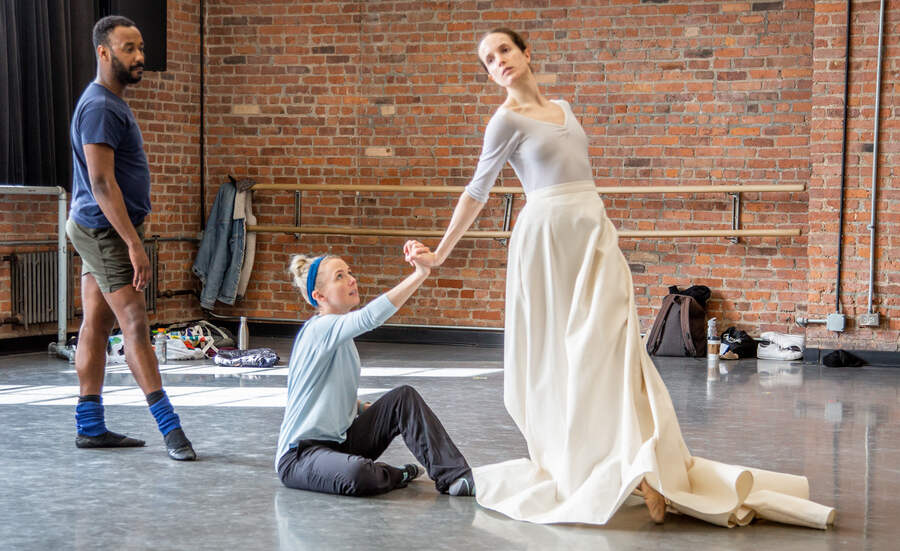Throughout her career as a dancer at some of the best companies in the country, former Metropolitan Opera dancer Morgan McEwen felt undervalued, creatively stifled, and disenfranchised by the sexism, misogyny, and mistreatment she encountered. Like many other women in the field, McEwen was shut out of artistic decisions, typecast for her looks, body-shamed, and sexualized.
Not only do classical ballets typically demean their female characters, but the dancers playing them are routinely made to work through injuries, they earn less than their male counterparts, and few hold leadership roles. On average, women dancers make $0.84 for every $1 made by white non-Hispanic men; women in leadership in the field also earn less than men in similar roles. In the 2021-2022 season, just 29 percent of ballets were choreographed by women.
After 10 years, six of them at the Met, experiencing this firsthand and fieldwide, McEwen set out to make the creative opportunities she craved for herself.
“It was a lot of things that led up to this point of, ‘I want to have a voice at the table, I want to be a choreographer,’ and the only way I can do that is if I make my own company,” she said. “I wanted to be the change I wanted to see in my community.”
In 2014, with $12,000 from an Indiegogo campaign, McEwen founded her own nonprofit ballet company, MorDance, with the intention of creating meaningful, beautiful stories that exploited neither the characters nor dancers portraying them. By constructing a supportive and safe work environment, offering fair pay and benefits and centering female and underrepresented voices, the woman-led, NYC-based MorDance is fostering a new generation of dancers and rewriting the stories ballets tell on- and offstage.
“Do we really need to see a woman lose her mind and then die from dancing, or Sleeping Beauty—this notion that a man needs to kiss a woman to wake her up,” McEwen asked rhetorically. “We’re a generation of women that don’t need to be kissed to wake up.”
Ballet has a tremendous capacity to educate and start conversations, but this is often overlooked by companies who put on the same ballets year after year, and effectively exclude audiences with high ticket prices and un-relatable stories, McEwen said. “Why aren’t we using ballet as a vehicle to talk about social justice and to talk about civic engagement—to talk about these things that I think audiences want to talk about?”
Over the last 10 years, MorDance staged a mix of classical ballets reimagined for the 21st century, like a Romeo and Juliet that gave women equal voices to the men, alongside new works. Humanism incorporated snippets of speeches by female leaders, including Malala Yousafzai and Josephine Baker, and Encounters featured musician Konstantin Soukhovetski playing piano onstage with the dancers, who broke the divide between dancer and musician by taking his hands and weaving his body into the story.
“I think what she’s doing is absolutely beautiful in a traditional sense, but it’s also very untraditional and it’s kind of breaking the stereotypes,” said Soukhovetski. “I really think that’s where the most interesting art happens is outside of the penciled-in margins of what you’re supposed to be doing.”
This year, for the company’s April show, MorDance will perform three original ballets: Emily, based on Emily Dickinson’s poem “They Shut Me Up in Prose,” the score for which Soukhovetski and violist Jesus Rodolfo will perform live; Albatross, inspired by a 2017 documentary by filmmaker Chris Jordan about how the giant seabirds mistakenly ingest plastics from polluted oceans and die, accompanied by music from composer Josh Knowles; and Stabat Mater, McEwen’s 2018 exploration of mourning and how we process feelings.

MorDance rehearses in studios across NYC, relying on arts subsidy grants that enable companies to rent their space for $10 an hour when they’re not in use. On a chilly, drizzly day in late February, inside Ballet Hispanico’s toasty warm Studio 9, I watched MorDancers practice the third movement of Emily. Claire van Bever ran in place alone as the central figure among two rows of stationary dancers. The motion was contagious, and as the other dancers picked it up, van Bever circulated through the group, iteratively entangling with them and breaking free, sometimes pushing dancers out of her way to signify Emily’s rejection of the ways society confines and defines her.
“She [McEwen] brings these political statements to her dance, which is not something that you see that often,” said dancer Camila Rodrigues. “Or if you see it, it’s a little boring to watch, but you really understand the message that she wants to bring through the movement.”
Making ballet legible is important to McEwen; MorDance offers open rehearsals and a fall “works in progress” show that dissects the work for the audience and invites them to ask questions.
To choreograph Emily, McEwen split “They Shut Me Up In Prose,” Dickinson’s tight, three-stanza rumination on a woman’s cultural restrictions, into five movements. Danced by rotating female soloists, Emily evolves from a carefree child into a young woman consciously self-censoring in response to the world around her, before growing into van Bever’s Emily, who has begun to speak up and resist. By the fourth movement, Emily has found her voice, and in the fifth movement, McEwen said, quoting Emily composer Polina Nazaykinskaya: “You become Meryl Streep. You’ve made your mark, you found your place, you’re being heard.”
MorDance rehearsals are punctuated with jokes and laughter. McEwen checks in with her dancers often, and they’re quick to raise hands and ask her questions or tell her when something isn’t working.
“I don’t question if Morgan wants to hear my opinion or not, because I already know based on how she’s treated me thus far,” van Bever told me. Almost subconsciously, she’s started to work primarily with female creative teams, because they respect her, she said. “I don’t think it has to be that way,” she continued. “I definitely think that male-presenting people can also lift up female voices or make it an equal experience for all—that just hadn’t been my majority experience.”
Many ballet company cultures perpetuate a double standard which holds up ballerinas onstage as ethereal, delicate, otherworldly beings, but offstage devalues them as expendable and interchangeable because they’re abundant. Conversely, stereotypically male-presenting dancers receive preferential treatment, and their bad behavior is often overlooked, because of their scarcity, MorDancer David Hochberg says.
“I think dance in general, speaking of America, and especially white Western culture, dance is not considered male—it’s not considered something that men do,” Hochberg said. “So within the dance world, when men dance, it’s precious. The dance culture covets them, on top of regular societal misogyny and patriarchy.”
Though he has benefited from this male privilege in other dance spaces, the equality and inclusivity McEwen strives for make MorDance feel welcoming. “I can feel safe being very queer, very femme in a studio,” Hochberg said. “I feel that more at MorDance than I have in most other places…I feel like I can bring more of myself to the studio.”
Indeed, classical ballet’s rigidly defined gender roles also leave little space for dancers who live outside them. Tevin Johnson, who identifies as non-binary and uses he/they pronouns, currently presents as male, but his slight frame, height (5’3”), and ability to appear femme mean they’re often placed in women’s roles and rarely dances men’s parts or lifts, outside of his work with MorDance. At MorDance, Johnson dictates what their body can do, and the trust he has with fellow dancers brings a completely different energy into the studio, they say.
Beyond resolving issues of inclusion, access, and relatability, for ballet to evolve completely, society needs to value art as a craft and a career, McEwen said.
“I believe that [my dancers] work as hard as lawyers and doctors, and they should be compensated for their hard work in a fair, equitable way,” she said. Leading by example, she raises dancer wages annually and keeps operation expenses minimal in order to pay her dancers as much as possible.
Ten years after founding MorDance, McEwen is living her own third act of Emily, and she too wants more than when she started out. Becoming a mother—McEwen’s daughter, Josephine is 2 years old—changed how she sees art. Telling powerful stories is her responsibility now.
“My daughter, when I speak to her, I have to speak with meaning and intent,” McEwen said. “And when I’m spending so much time making a piece of art, it can’t just be pretty—it has to tell a story.”
“It would be easy to say, ‘Let’s make something ugly,’ and therefore it will break the boundary,” said Soukhovetski. Instead McEwen balances challenging stories with beautiful performances. “Art is truth—it has a tremendous power to influence a society.”
In another 10 years, McEwen will be in her fourth act, she hopes, with a dedicated MorDance studio. Ballet education that is accessible to all is an essential piece of changing its narratives, and she hopes to offer subsidized ballet classes. MorDance already travels to local schools to perform and speak to students, intending to make the closed-off world of ballet feel approachable.
The students inspire her with their courage, openness, and honesty, McEwen said. “I think the next generation of people deserve an art form that speaks to them.”
MorDance’s Spring Season shows are at 7:30 p.m. April 28th and 29th at Gerald W. Lynch Theater. Tickets at mordance.org.
Meredith Lawrence (she/her) is an award-winning writer and photographer based in Brooklyn, NY. Her work has appeared in Vox, Alta Journal, GRAMMY.com, and many more.


